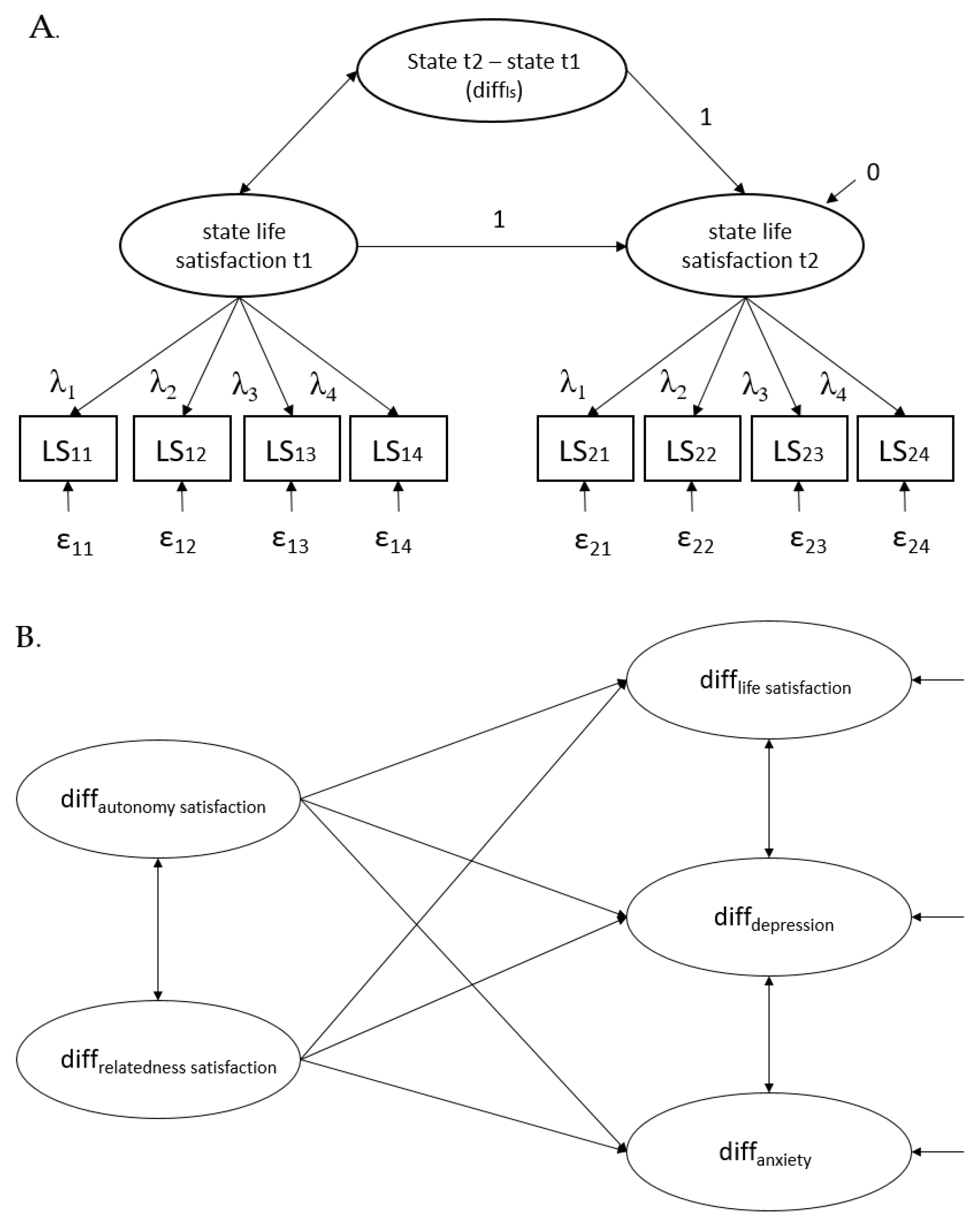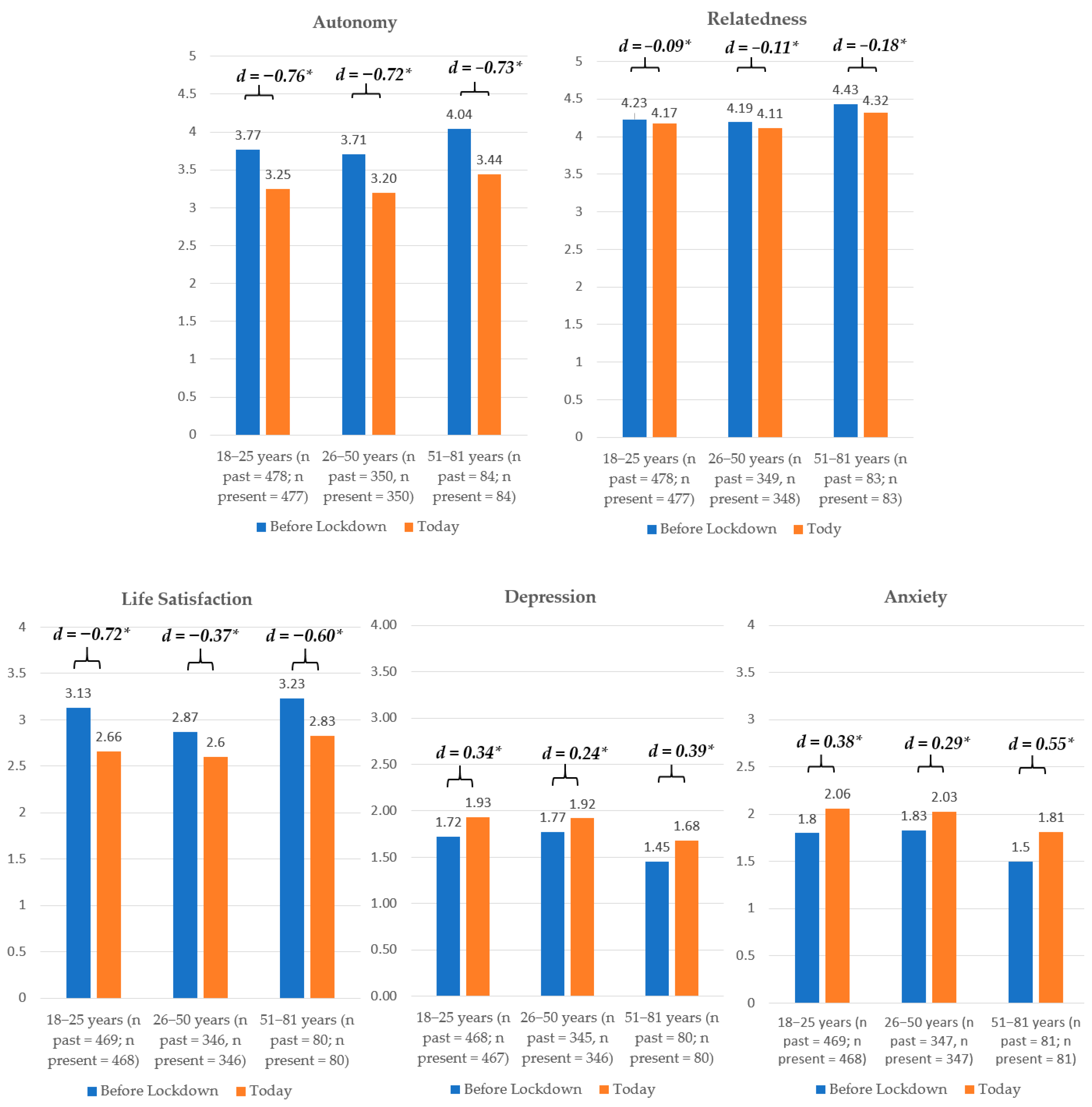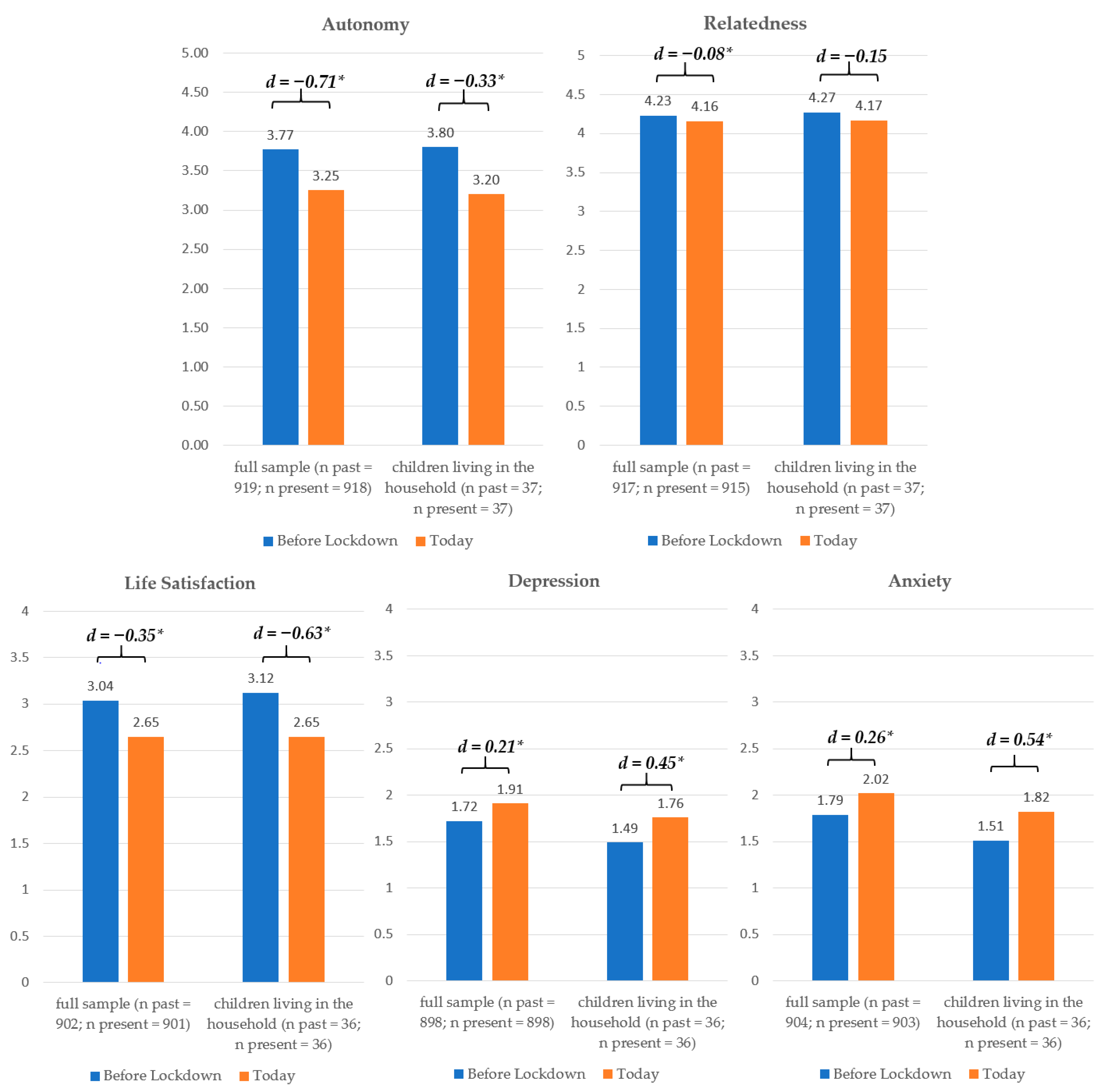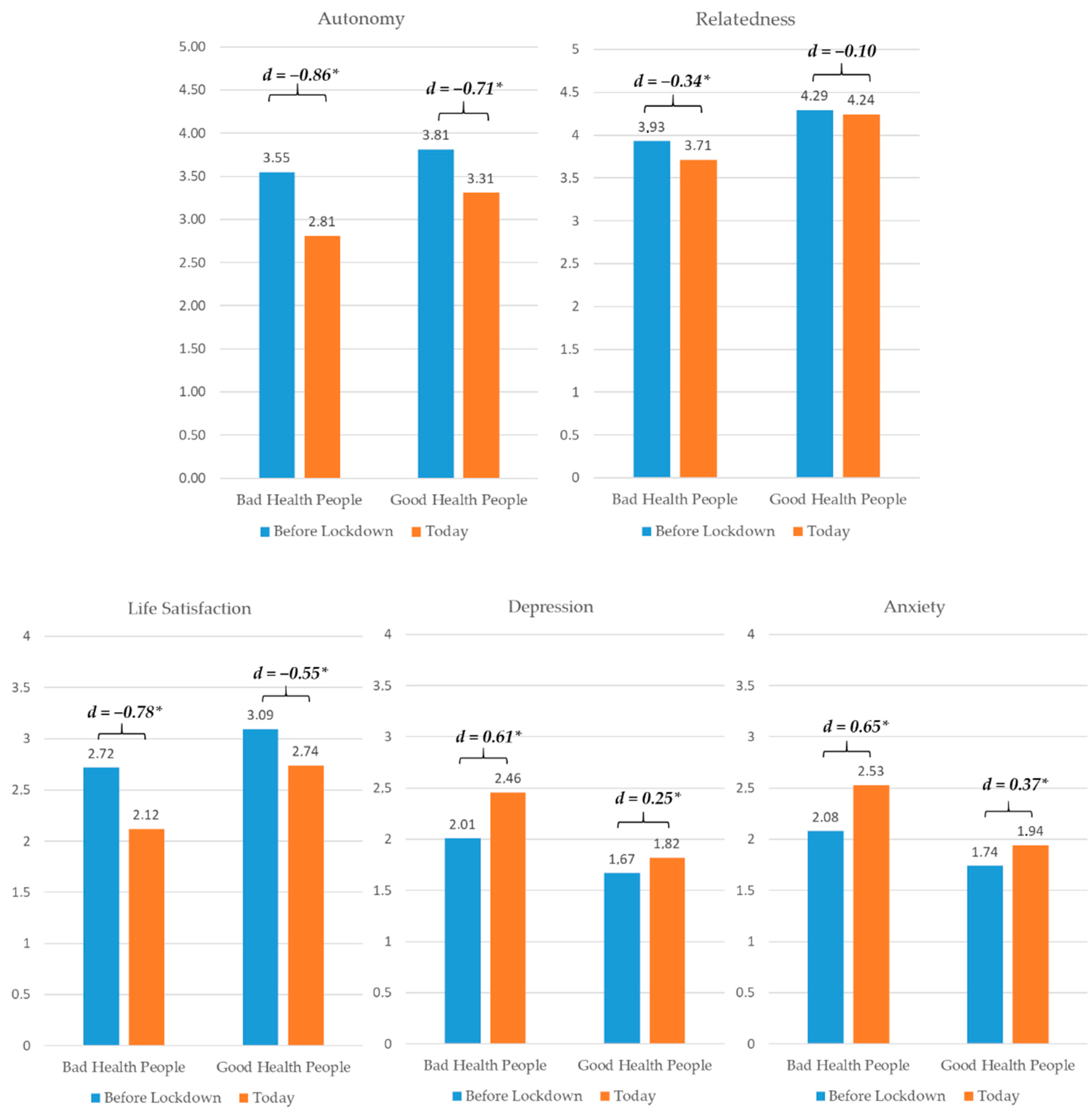Psychological Impact of Corona Lockdown in Germany: Changes in Need Satisfaction, Well-Being, Anxiety, and Depression
Abstract
1. Introduction
1.1. Corona Lockdown in Germany
1.2. Satisfaction of Basic Psychological Needs
1.3. The Present Research
2. Materials and Methods
2.1. Sample, Procedure, and Measures
2.2. Statistical Analyses
3. Results
4. Discussion
5. Conclusions
Author Contributions
Funding
Conflicts of Interest
References
- COVID-19 Dashboard by the Center for System Science and Engineering (CSSE) at John Hopkins University. Available online: https://coronavirus.jhu.edu/map.html (accessed on 14 October 2020).
- Mucci, F.; Mucci, N.; Diolaiuti, F. Lockdown and isolation: Psychological aspects of COVID-19 pandemic in the general population. Clin. Neuropsychiatry J. Treat. Eval. 2020, 17, 63–64. [Google Scholar] [CrossRef]
- Ren, X.; Huang, W.; Pan, H.; Huang, T.; Wang, X.; Ma, Y. Mental health during the Covid-19 outbreak in China: A Meta-Analysis. Psychiatr. Q. 2020, 1–13. [Google Scholar] [CrossRef]
- Ryan, R.M.; Deci, E.L. Self-determination theory and the facilitation of intrinsic motivation, social development, and well-being. Am. Psychol. 2000, 55, 68–78. [Google Scholar] [CrossRef] [PubMed]
- Chen, B.; Vansteenkiste, M.; Beyers, W.; Boone, L.; Deci, E.L.; Van der Kaap-Deeder, J.; Ryan, R.M. Basic psychological need satisfaction, need frustration, and need strength across four cultures. Motiv. Emot. 2015, 39, 216–236. [Google Scholar] [CrossRef]
- Pieh, C.; Budimir, S.; Probst, T. The effect of age, gender, income, work, and physical activity on mental health during coronavirus disease (COVID-19) lockdown in Austria. J. Psychosom. Res. 2020, 136, 110186. [Google Scholar] [CrossRef] [PubMed]
- Lüdecke, D.; von dem Knesebeck, O. Protective behavior in course of the COVID-19 outbreak—Survey results from Germany. Front. Public Health 2020, 8, 567. [Google Scholar] [CrossRef] [PubMed]
- Mutz, M.; Gerke, M. Sport and exercise in times of self-quarantine: How Germans changed their behaviour at the beginning of the COVID-19 pandemic. Int. Rev. Sociol. Sport 2020, 1012690220934335. [Google Scholar] [CrossRef]
- Davenport, M.H.; Meyer, S.; Meah, V.L.; Strynadka, M.C.; Khurana, R. Moms are not ok: COVID-19 and maternal mental health. Front. Glob. Women’s Health 2020, 1, 1. [Google Scholar] [CrossRef]
- Hoenig, K.; Wenz, S.E. Education, health behavior, and working conditions during the pandemic: Evidence from a German sample. Eur. Soc. 2020, 1–14. [Google Scholar] [CrossRef]
- Röhr, S.; Müller, F.; Jung, F.; Apfelbacher, C.; Seidler, A.; Riedel-Heller, S.G. Psychosoziale Folgen von Quarantänemaßnahmen bei schwerwiegenden Coronavirus-Ausbrüchen: Ein Rapid Review. Psychiatr. Prax. 2020, 47, 179. [Google Scholar] [CrossRef] [PubMed]
- Ryan, R.M.; Deci, E.L. Self-Determination Theory: Basic Psychological Needs in Motivation, Development, and Wellness; Guilford Publications: New York, NY, USA, 2017. [Google Scholar]
- Vansteenkiste, M.; Ryan, R.M.; Soenens, B. Basic psychological need theory: Advancements, critical themes, and future directions. Motiv. Emot. 2020, 44, 1–31. [Google Scholar] [CrossRef]
- Ng, J.Y.; Ntoumanis, N.; Thøgersen-Ntoumanis, C.; Deci, E.L.; Ryan, R.M.; Duda, J.L.; Williams, G.C. Self-determination theory applied to health contexts: A meta-analysis. Perspect. Psychol. Sci. 2012, 7, 325–340. [Google Scholar] [CrossRef] [PubMed]
- Yu, S.; Levesque-Bristol, C.; Maeda, Y. General need for autonomy and subjective well-being: A meta-analysis of studies in the US and East Asia. J. Happiness Stud. 2018, 19, 1863–1882. [Google Scholar] [CrossRef]
- Soenens, B.; Luyckx, K.; Vansteenkiste, M.; Luyten, P.; Duriez, B.; Goossens, L. Maladaptive perfectionism as an intervening variable between psychological control and adolescent depressive symptoms: A three-wave longitudinal study. J. Fam. Psychol. 2008, 22, 465–474. [Google Scholar] [CrossRef] [PubMed]
- Heissel, A.; Pietrek, A.; Flunger, B.; Fydrich, T.; Rapp, M.A.; Heinzel, S.; Vansteenkiste, M. The validation of the German basic psychological need satisfaction and frustration scale in the context of mental health. Eur. J. Health Psychol. 2018, 25, 119–132. [Google Scholar] [CrossRef]
- Trautwein, U. Die temporalen Facetten der Lebenszufriedenheit. Diagnostica 2004, 50, 182–192. [Google Scholar] [CrossRef]
- Laux, L.; Hock, M.; Bergner-Köther, R.; Hodapp, V.; Renner, K.-H. Das State-Trait-Angst-Depressions-Inventar (STADI) [The State-Trait-Anxiety-Depression-Inventory (STADI)]; Hogrefe: Göttingen, Germany, 2013. [Google Scholar]
- Muthén, L.K.; Muthén, B.O. Mplus User’s Guide, 8th ed.; Muthén & Muthén: Los Angeles, CA, USA, 1998–2017. [Google Scholar]
- Ellis, W.E.; Dumas, T.M.; Forbes, L.M. Physically isolated but socially connected: Psychological adjustment and stress among adolescents during the initial COVID-19 crisis. Can. J. Behav. Sci. 2020, 52, 177–187. [Google Scholar] [CrossRef]
- BMG. Erste Ergebnisse der BMG-„Corona-BUND-Studie; Ifo-Institut: München, Germany, 2020. [Google Scholar]
- Rettie, H.; Daniels, J. Coping and tolerance of uncertainty: Predictors and mediators of mental health during the COVID-19 pandemic. Am. Psychol. 2020. [Google Scholar] [CrossRef] [PubMed]




| Scale | T1 | T2 | Mean Differences | |||
|---|---|---|---|---|---|---|
| M (SD) | α | M (SD) | α | t (df)T1–T2 | dT1–T2 | |
| (1) Autonomy | 3.78 (0.71) | 0.76 | 3.25 (0.74) | 0.73 | −22.30 * (917) | −0.71 |
| (2) Relatedness | 4.24 (0.67) | 0.82 | 4.16 (0.74) | 0.80 | −4.26 * (914) | −0.15 |
| (3) Well-Being | 3.04 (0.65) | 0.89 | 2.65 (0.71) | 0.83 | −17.33 * (900) | −0.59 |
| (4) Anxiety | 1.79 (0.64) | 0.74 | 2.02 (0.70) | 0.78 | 12.47 * (902) | 0.40 |
| (5) Depression | 1.71 (0.58) | 0.80 | 1.91 (0.69) | 0.83 | 8.94 * (896) | 0.32 |
Publisher’s Note: MDPI stays neutral with regard to jurisdictional claims in published maps and institutional affiliations. |
© 2020 by the authors. Licensee MDPI, Basel, Switzerland. This article is an open access article distributed under the terms and conditions of the Creative Commons Attribution (CC BY) license (http://creativecommons.org/licenses/by/4.0/).
Share and Cite
Schwinger, M.; Trautner, M.; Kärchner, H.; Otterpohl, N. Psychological Impact of Corona Lockdown in Germany: Changes in Need Satisfaction, Well-Being, Anxiety, and Depression. Int. J. Environ. Res. Public Health 2020, 17, 9083. https://doi.org/10.3390/ijerph17239083
Schwinger M, Trautner M, Kärchner H, Otterpohl N. Psychological Impact of Corona Lockdown in Germany: Changes in Need Satisfaction, Well-Being, Anxiety, and Depression. International Journal of Environmental Research and Public Health. 2020; 17(23):9083. https://doi.org/10.3390/ijerph17239083
Chicago/Turabian StyleSchwinger, Malte, Maike Trautner, Henrike Kärchner, and Nantje Otterpohl. 2020. "Psychological Impact of Corona Lockdown in Germany: Changes in Need Satisfaction, Well-Being, Anxiety, and Depression" International Journal of Environmental Research and Public Health 17, no. 23: 9083. https://doi.org/10.3390/ijerph17239083
APA StyleSchwinger, M., Trautner, M., Kärchner, H., & Otterpohl, N. (2020). Psychological Impact of Corona Lockdown in Germany: Changes in Need Satisfaction, Well-Being, Anxiety, and Depression. International Journal of Environmental Research and Public Health, 17(23), 9083. https://doi.org/10.3390/ijerph17239083






